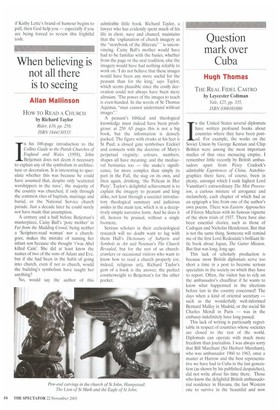When believing is not all there is to seeing
Allan Mallinson
How TO READ A CHURCH by Richard Taylor Rider, £10, pp. 250, ISBN 1844130533 Tn his 100-page introduction to the Collins Guide to the Parish Churches of England and Wales (1958), John
Betjeman does not deem it necessary to explain any of the symbolism in architecture or decoration. It is interesting to speculate whether this was because he could have assumed that, despite only 'scattered worshippers in the nave', the majority of the country was churched, if only through the common rites of baptism, marriage and burial, or the National Service church parade. Just a decade later he could surely not have made that assumption.
A century and a half before Betjeman's masterpiece, Cainy Ball's 'pore mother' in Far from the Madding Crowd, being neither a 'Scripture-read woman' nor a churchgoer, makes the mistake of naming her infant son because she thought Twas Abel killed Cain'. She did at least know the names of two of the sons of Adam and Eve, but if she had been in the habit of going into church, even if not to church, would the building's symbolism have taught her anything?
No, would say the author of this
admirable little book. Richard Taylor, a lawyer who has evidently spent much of his life in choir, nave and chancel, maintains that the 'explanation of church imagery as the "storybook of the illiterate" ' is unconvincing. Cainy Ball's mother would have had to be familiar with the basics, whether from the page or the oral tradition, else the imagery would have had nothing reliably to work on. 'I do not believe that these images would have been any more useful for the peasant than for the king,' says Taylor, which seems plausible since the costly decoration could not always have been mere altruism. 'The power of the images to teach is even-handed. In the words of St Thomas Aquinas, "man cannot understand without images":
A peasant's biblical and theological knowledge must indeed have been prodigious: at 250 AS pages this is not a big book, but the information is densely packed. The figure with cloaks at his feet is St Paul; a closed gate symbolises Ezekiel and connects with the doctrine of Mary's perpetual virginity; colours, numbers, shapes all have meaning; and the mediaeval bestiaries too — the snake's significance, far more complex than simply its part in the Fall, the stag on its own, and then again, drinking, 'the Pelican in Her Piety'. Taylor's delightful achievement is to explain the imagery to peasant and king alike, not least through a succinct introductory theological summary and judicious asides in the main text, which is in a deceptively simple narrative form. And he does it all, heaven be praised, without a single footnote.
Serious scholars in their ecclesiological research will no doubt want to lug with them Hall's Dictionary of Subjects and Symbols in Art and Noonan's The Church Revealed, but for the rest of us churchcrawlers or occasional visitors who want to know how to read a church properly (or, indeed, religious art), Richard Taylor's gem of a book is the answer, the perfect counterweight to Betjeman's for the other pocket.


























































































 Previous page
Previous page